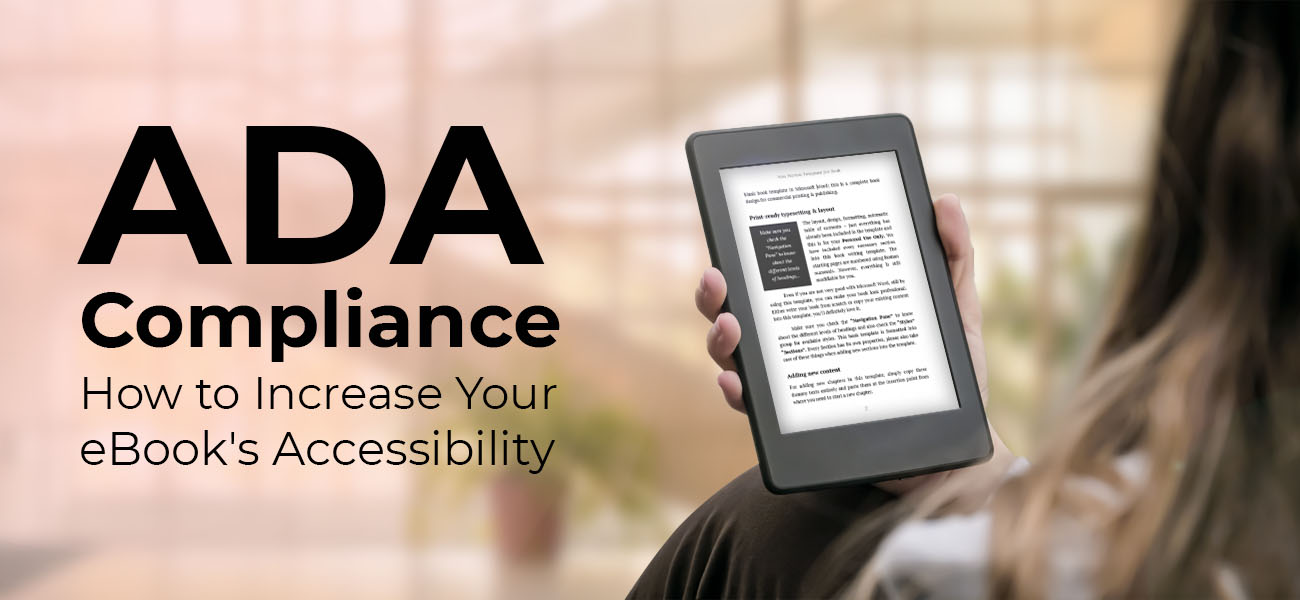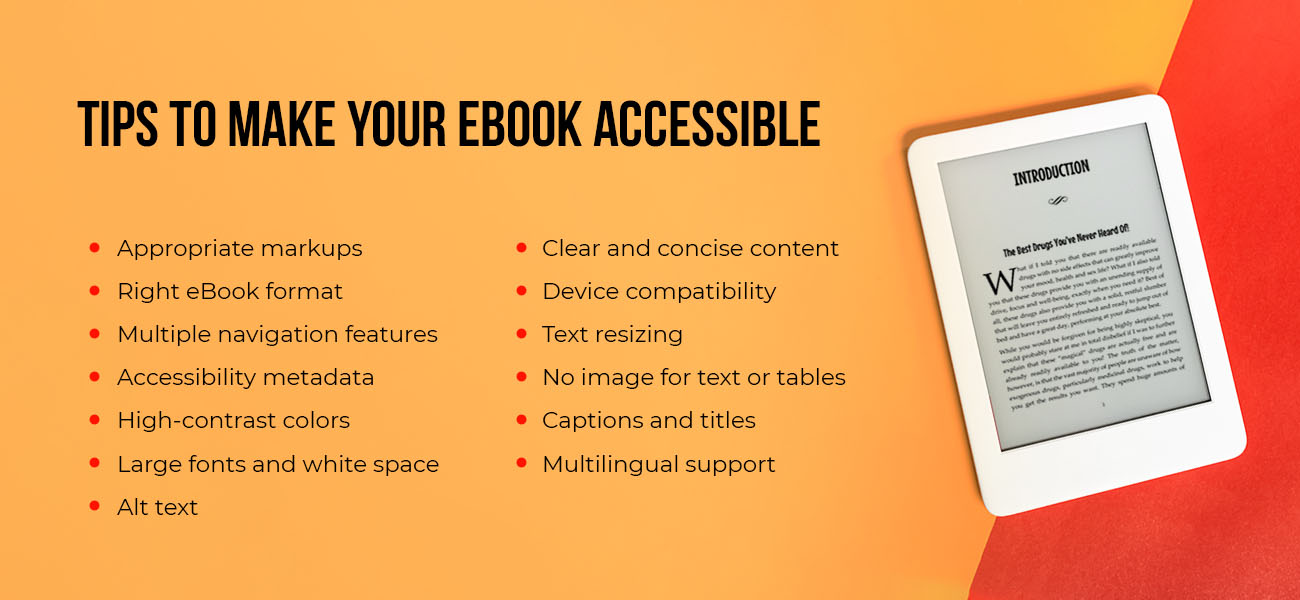‘Accessibility’ is an important concept that makes it possible for differently-abled people to have a normal life. This is made compulsory by the Americans with Disabilities Act (ADA). That is why you have parking spots reserved with a wheelchair sign and ramps and handrails along the stairs. But did you know that this ADA compliance is also a must for digital content, including eBooks?
Considering that eBook accessibility is an important topic, whether you are an author or eBook publisher, we have prepared this simple guide. We’ll learn:
- What is ADA compliance?
- If eBook accessibility is mandatory?
- What makes an electronic book accessible? and
- How to make eBooks accessible?
Note: There are other guidelines and standards (like the WCAG) that aim to make digital content accessible. However, this article will only cover eBook accessibility under the Americans with Disabilities Act (ADA) Standards for Accessible Design.
Shall we get started?
What is ADA compliance?
ADA compliance means following the rules set by the ADA Standards for Accessible Design. These rules and guidelines make sure that people with disabilities get the same knowledge as everyone else and participate in the same activities.

When it comes to electronic and informational technology (including websites and eBooks), this act aims at accessibility for the blind or those with vision impairments or reading disabilities. In simple words, ADA compliance means making it easier for those with visual, reading, and learning disabilities to consume and enjoy digital content.
The goal of accessibility is to give differently abled people alternate ways to access digital content.
Note: The WCAG is the best framework to follow if you want to be ADA-compliant. Many courts have even asked websites to reach WCAG 2.0 Level AA compliance.
Is it mandatory for all eBooks to be ADA-compliant?
Currently, the ADA does not require compliance from all eBooks (except educational material). Even though it is not mandatory, consider making your digital books accessible using the ADA’s guidelines. This will help you avoid possible future legal troubles and fines. It will also increase your eBook’s reach and make it a pleasant experience for your readers.
Educational books, on the other hand, must comply with the ADA’s rules. According to the ADA, people with disabilities should have equal access to all educational benefits and opportunities that are available online or in other digital formats. Such requirements prevent scenarios where differently abled people can’t access vital information needed to complete their education.
What are the features of an accessible eBook?
An eBook is accessible when people with visibility issues can easily read its content. One of the important features that makes digital books accessible is that their content can be modified with assistive technologies (like screen readers) so the visually and print-impaired can read it. Here are some other factors that make an eBook ADA-compliant:
- Readers with disabilities can easily understand the content in the eBook.
- They can be read with audio (including text-to-speech), Braille, or large prints.
- Readers can easily use and interact with it.
- It has a simple and sequential structure that makes the content easy to understand.
- The content is accessible over time.
How to make your eBook accessible?
You may think that it is hard to make eBooks accessible, but it isn’t really that tough. There are simple things you can do to improve your eBook’s accessibility. For example, you can:
- Allow text magnification.
- Change the background and text colors so that it is easier to read.
- Enable text-to-speech.
- Make your content compatible with assistive technologies.

However, you must pay attention to detail and strictly follow the guidelines when making your digital books accessible.
Even publishing platforms like Amazon’s Kindle Direct Publishing, have made it easy for authors to comply with the ADA by issuing guidelines based on the law.
Now, let’s dive deeper into how to make digital books accessible and ADA-compliant.
Use appropriate markup to organize your content
Markup is a process where key elements of an eBook (like headings, sub-headings, etc.) are marked with standard tags. For example, using the H1 tag for your main title and marking the immediate sub-heading with the H2 header tag, instead of simply changing the font size and weight. Markup can be done by using coding or markup languages like HTML.
Markup includes semantic elements like headings, paragraphs, lists, tables, alt text for images, links, and more. Semantic markups help assistive technologies like screen readers understand the structure and elements of the content so the users can easily navigate through the eBook.
For mathematical content, use the MathML markup for improved accessibility. For images that don’t add important information to the content, mark them as decorative so that the screen readers can skip them.
Ensure proper eBook formatting
eBook format is the overall layout and design of the content. It is similar to markup; however, the focus is more on aesthetics and user experience than navigation. Formatting includes things like font style and size, line spacing, page orientation, margins, cover design, and more.
Formats are needed to make digital content easy to read on various devices like phones, eReaders, desktops, and more. Following the standard formats will also make your eBooks look visually appealing.
EPUB is currently the most popular eBook format. Almost every reader platform supports it, and it is quite reader-friendly. EPUB 3, the latest version of this format based on HTML5, even lets you to incorporate (embed) video, audio, and interactive multimedia elements.
However, it would be preferable to choose the eBook format that is recommended by the publishing platform you are using. That said, you can’t go wrong with EPUB.
Include multiple navigation features
Give your readers more than one way to navigate your eBook. Create a table of contents with linked chapters and subheadings to help readers locate specific points in your digital book. You can also improve navigation by adding markers to indicate print page breaks and including page lists.
Include accessibility metadata
Metadata about your eBook’s accessibility informs the reader about the accessibility features and offers guidance on how to access them. It can be embedded in your digital books.
Use high-contrast color schemes
High-contrast colors will allow those with poor vision or color blindness to see and read your text easily. Contrasting colors are also important for any illustrations and images in the eBook. The idea is to make the fonts stand out from the background.
You can use combinations like light yellow text on a dark red background. Or you can make your work easier by sticking to the traditional black and white combination. Use only two or three colors, as too many colors can confuse visually impaired readers. According to the WCAG standards, the minimum contrast ratio should be 4:5:1.
While you are at it, don’t use thin, light-colored fonts, as they can make it more difficult to read.
Use large fonts and plenty of white space
Use large fonts in your digital books to make reading easier. Doing this will also help people without disabilities, as it prevents eye strain.
Including plenty of white space in your eBooks also makes reading easier for those with poor visibility.
Add alternative text to images and videos
Alternative text (or alt text) is added to images and videos, and their job is to describe the appearance and what their function is on that page. This is not the same as the description under images. Alternative text is included in the HTML code of an image and is not visible in normal situations. You will only see them in the place of a picture or video when the page has not loaded properly.
However, screen readers can read this alt text aloud for the visually impaired to understand the content and context of the image.
It is easier to explain pictures with alternative text. However, videos can be a little tricky. To make the visually- and hearing-impaired readers understand the video and follow along, you can add the transcript.
Make the language clear and concise
Try not to use technical terms and jargon in your eBook, as not all your readers may understand what you have written. This is a good rule of thumb to follow for writing in general (unless you are writing on technical subjects). As much as possible, try using simple and concise language so the reader can understand easily. That way, they won’t need to struggle to look up the meanings.
Make the eBook compatible
For your eBook to be considered compatible, people should be able to open and read it on their phones, tablets, computers, eReaders, or other devices. Use a format that will ensure that the text and multimedia content will fit any screen and font size correctly. This will make it comfortable and easy for the readers to enjoy your content on their preferred device. You can do this by making your text reflowable, using file types and formats that can be viewed on any device, and more.
Allowing text resizing
Allow your readers to change the font size so they can read the content comfortably. Some readers prefer larger font sizes, while others prefer to read the normal size using their reading glasses. Either way, it is better to leave it up to the reader to decide what font size they want to use. The point is to prevent eye strain and make it easy the visually impaired to read.
You just have to ensure that the size won’t affect the layout of the book. Remember that captions and text in images can’t be resized. So, you will have to set a comfortable size for them yourself.
Avoid using images for tables and text
Don’t use images to depict tables and text, as assistive devices are not able to read them. If you want to depict things with some style (like with pull quotes), use CSS to get the effect you want.
Accurately caption and label non-text content and tables
Always add captions for the images, videos, tables, and charts in your eBook to add context. Captions will help your readers understand the the contents of the graphical element or table.
Remember to also properly label your tables by adding row and column headings, so they are easier to grasp. Make your captions and labels descriptive and straightforward to avoid any confusion.
Ensure multilingual support
Even if your eBook is written in one language, there might be some phrases or words that have been borrowed from other languages. To improve the accessibility of your eBook, accurately mark these foreign phrases and to guide the eReader or reading app correctly to the meaning.
Most eReaders and devices have the commonly used fonts in their systems. If you are using an unusual font, embed the appropriate fonts in your eBook in case the eReader or app doesn’t have the font in their system.
Wrapping up
Making an ADA-compliant eBook and ensuring accessibility is not complicated. To ensure that everyone can enjoy your digital books, just be aware of the rules and pay close attention to detail.
Inclusivity will help your eBooks become successful, especially if you are a new author. If you ever need a hand navigating the world of eBook creation, there are many eBook conversion specialists you can consult or outsource to for the best results.
All the best with your eBook publishing!

